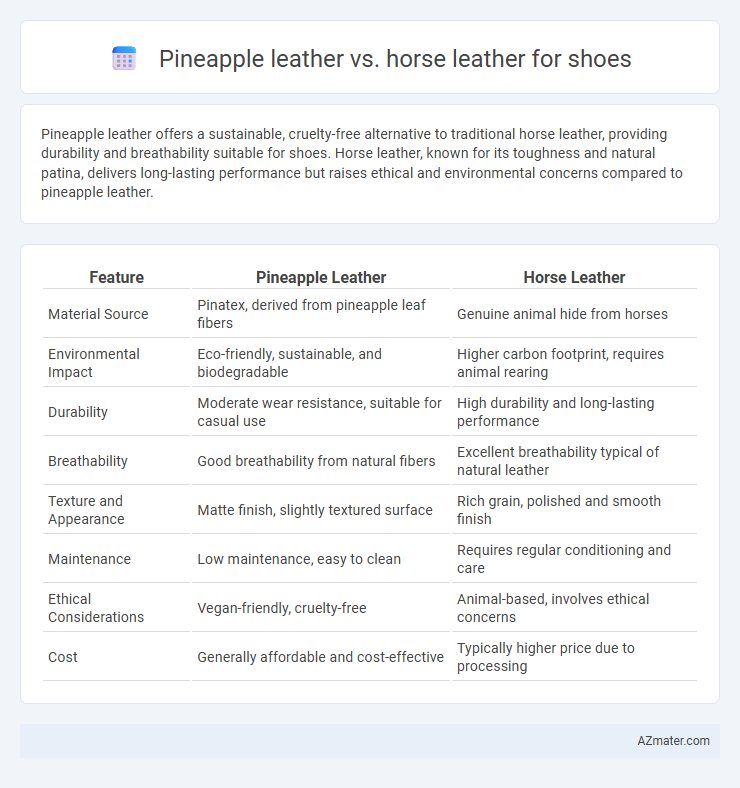Pineapple leather offers a sustainable, cruelty-free alternative to traditional horse leather, providing durability and breathability suitable for shoes. Horse leather, known for its toughness and natural patina, delivers long-lasting performance but raises ethical and environmental concerns compared to pineapple leather.
Table of Comparison
| Feature | Pineapple Leather | Horse Leather |
|---|---|---|
| Material Source | Pinatex, derived from pineapple leaf fibers | Genuine animal hide from horses |
| Environmental Impact | Eco-friendly, sustainable, and biodegradable | Higher carbon footprint, requires animal rearing |
| Durability | Moderate wear resistance, suitable for casual use | High durability and long-lasting performance |
| Breathability | Good breathability from natural fibers | Excellent breathability typical of natural leather |
| Texture and Appearance | Matte finish, slightly textured surface | Rich grain, polished and smooth finish |
| Maintenance | Low maintenance, easy to clean | Requires regular conditioning and care |
| Ethical Considerations | Vegan-friendly, cruelty-free | Animal-based, involves ethical concerns |
| Cost | Generally affordable and cost-effective | Typically higher price due to processing |
Introduction to Pineapple Leather and Horse Leather
Pineapple leather, also known as Pinatex, is an innovative, sustainable material derived from pineapple leaf fibers, offering an eco-friendly alternative to traditional animal leathers. Horse leather is prized for its durability, flexibility, and distinctive grain pattern, commonly used in high-quality footwear for its strength and unique texture. Comparing pineapple leather and horse leather highlights key differences in environmental impact, texture, and sourcing, influencing consumer choices in the shoe industry.
Sustainability: Pineapple Leather vs Horse Leather
Pineapple leather offers a highly sustainable alternative to traditional horse leather by utilizing agricultural waste from pineapple plants, significantly reducing carbon emissions and water consumption during production. In contrast, horse leather involves animal farming and slaughter, which contribute to higher environmental impacts such as deforestation, methane emissions, and ethical concerns. The biodegradable nature of pineapple leather further enhances its eco-friendly profile compared to the slower biodegradation rate of conventional animal leather.
Durability and Longevity Compared
Pineapple leather, derived from sustainably processed Pinatex fibers, offers impressive durability but generally falls short of traditional horse leather in terms of longevity and resistance to wear. Horse leather, known for its dense fiber structure and natural resilience, typically withstands daily abrasion and environmental stress longer, making it ideal for high-quality shoes with extended lifespan expectations. While pineapple leather provides an eco-friendly alternative with moderate durability, horse leather remains superior for consumers prioritizing maximum shoe longevity and durability.
Comfort and Wearability Factors
Pineapple leather, derived from the fibers of pineapple leaves, offers lightweight breathability and natural moisture-wicking properties, enhancing comfort during prolonged wear. Horse leather boasts exceptional durability and molds to the foot over time, providing a snug, personalized fit that improves wearability. While pineapple leather excels in eco-friendly softness, horse leather remains superior in long-term resilience and support for shoe applications.
Aesthetic Qualities and Finishes
Pineapple leather offers a unique, textured surface with a natural matte finish that highlights its eco-friendly origins, providing a modern and vegan alternative to traditional materials. Horse leather is renowned for its smooth, glossy finish and rich patina that develops over time, lending shoes a classic, luxurious aesthetic. While pineapple leather emphasizes sustainability and distinct patterns, horse leather delivers durability and a polished, high-end appearance favored in premium footwear.
Maintenance and Care Differences
Pineapple leather, made from natural pineapple fibers, requires gentle cleaning with a damp cloth and occasional conditioning with plant-based oils to maintain its texture and prevent drying. Horse leather demands more intensive care, including regular brushing, specialized leather conditioners, and waterproofing treatments to preserve its durability and prevent cracking. Unlike horse leather, pineapple leather is less prone to water damage but needs protection from prolonged exposure to direct sunlight to avoid fading.
Cost and Market Availability
Pineapple leather, derived from sustainable pineapple leaf fibers, generally costs more due to its eco-friendly production process and limited manufacturing scale. Horse leather is traditionally less expensive and widely available in the market because of established supply chains and higher production volumes. The niche demand for pineapple leather creates scarcity in the market, whereas horse leather benefits from a long-standing, robust global distribution network.
Ethical and Environmental Impacts
Pineapple leather, derived from renewable pineapple leaves, significantly reduces environmental harm by minimizing waste and avoiding animal cruelty compared to traditional horse leather, which involves animal exploitation and higher carbon emissions. The production of pineapple leather consumes less water and emits fewer greenhouse gases, making it a sustainable alternative in the footwear industry. Choosing pineapple leather supports ethical consumerism and reduces the ecological footprint associated with conventional horse leather shoes.
Popular Brands Using Each Material
Pineapple leather, a sustainable alternative made from Pinatex, is favored by brands like Adidas and Hugo Boss for eco-friendly shoe collections prioritizing vegan materials. Horse leather, known for durability and premium texture, is utilized by luxury brands such as Gucci and Bally, renowned for high-end craftsmanship and heritage appeal. Each material serves distinct consumer values, with pineapple leather targeting environmentally conscious buyers and horse leather appealing to traditional leather enthusiasts seeking quality and long-lasting wear.
Final Verdict: Which Leather is Best for Shoes?
Pineapple leather, derived from sustainable Pinatex fibers, offers a lightweight, eco-friendly alternative to traditional horse leather, which is prized for its durability, strength, and natural breathability. While horse leather provides superior longevity and molding properties ideal for high-quality footwear, pineapple leather excels in ethical appeal and moisture resistance but may lack the same wear resistance. Choosing the best leather depends on priority: sustainability and innovation favor pineapple leather, whereas endurance and classic texture favor horse leather for shoes.

Infographic: Pineapple leather vs Horse leather for Shoe
 azmater.com
azmater.com